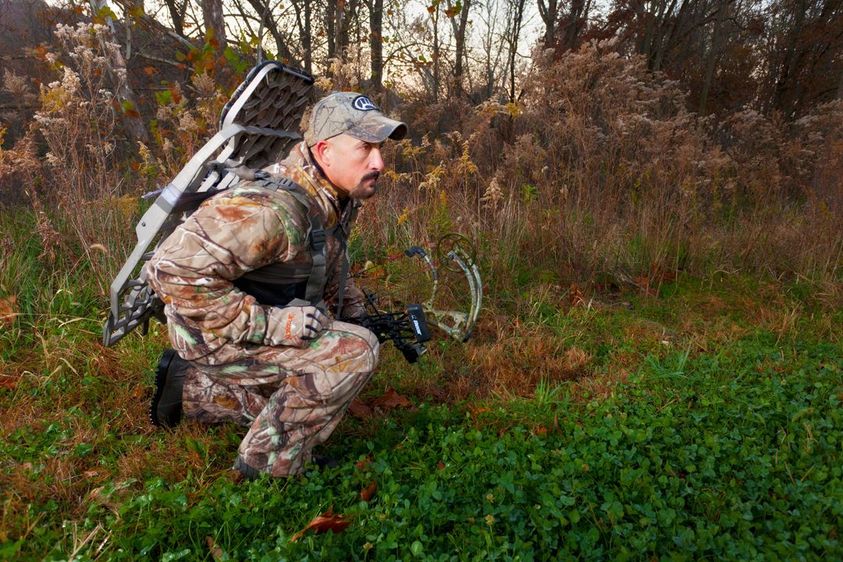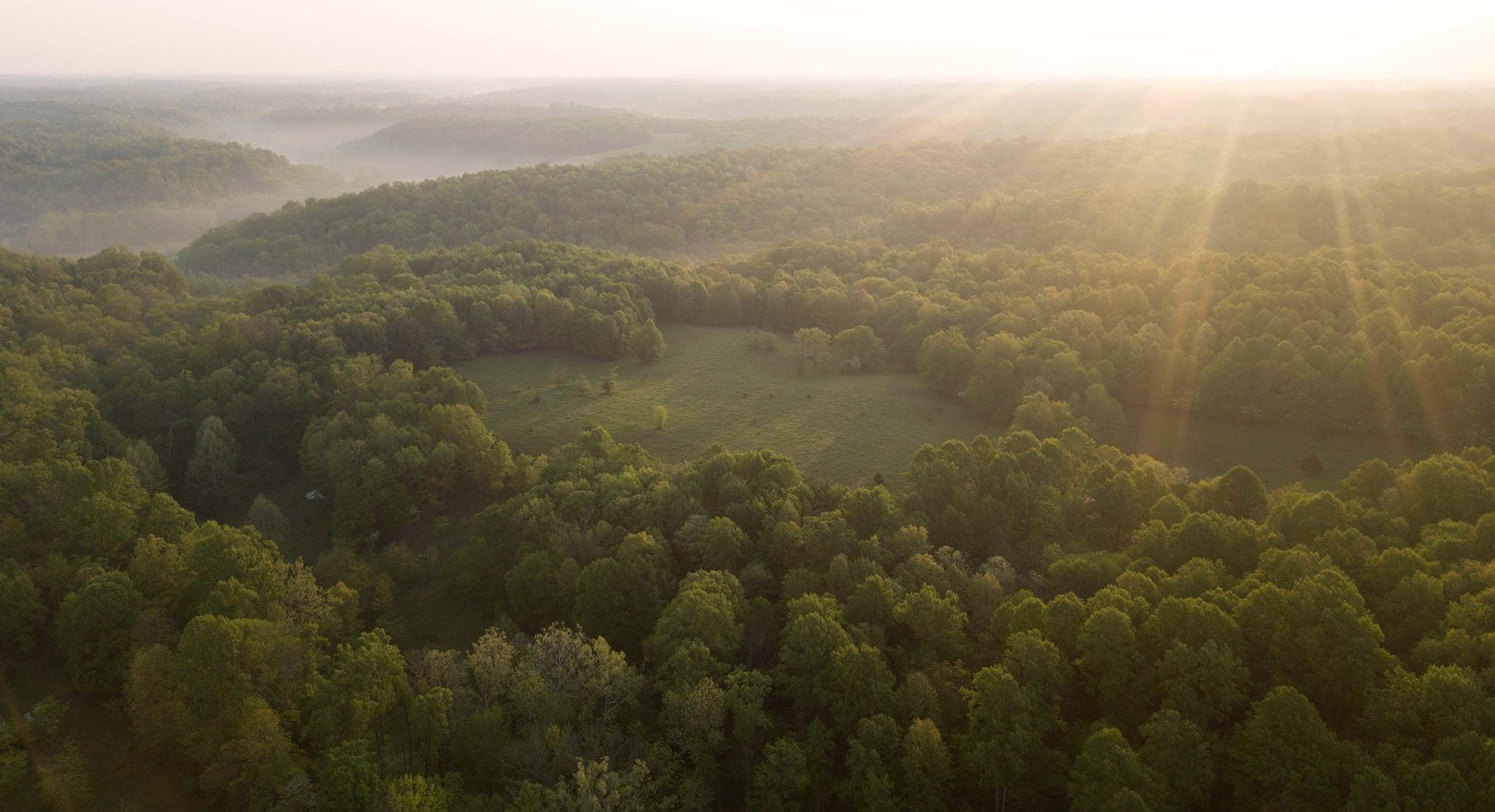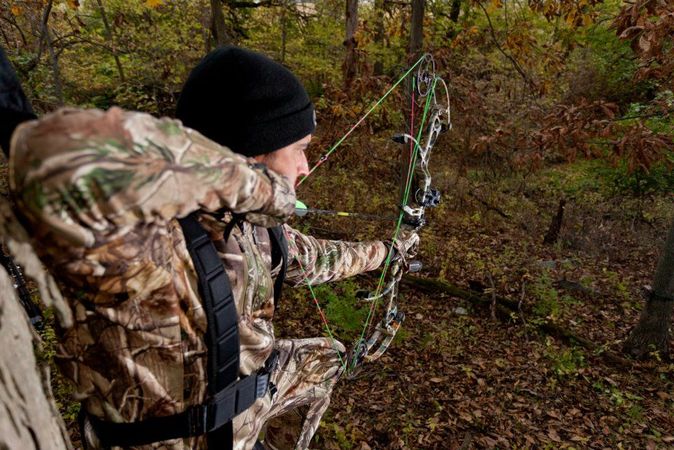Gently clicking the truck door behind, B.B. Craig quietly picked his way through timber toward his tree stand. Brightening the pre-dawn darkness with a flashlight, the 53-year-old Georgia bowhunter liked what he saw. The cloudy overcast, cool temperature and slight northern breeze offered the assurance of day-long deer movement.
“Fantastic,” thought Craig. “This is going to be the day!” Along the way he thought about the hours of scouting that went into the selection of his stand location.
Once he reached the big pine tree, he quickly climbed 18 feet, set the bow across his lap and prepared himself for daylight. Shortly, at a distance, a horned owl proclaimed sunlight was on its way.
As light slowly peeked out over the eastern horizon, the darkness began to fade. Suddenly, the sound of a twig snapping sent a surge of adrenaline racing through the hunter’s body. Craig eased up from his seat and lifted his bow to a ready position, his eyes focused on a small clearing 25 yards away. Craig figured that’s where he would first see the deer. Seconds later, a small doe stepped out of the brush. Craig just watched as she fed by.
“Well, that’s the way it goes,” he told himself. Seconds later, as he laid his bow back across his lap, out of the corner of his eye he caught another flicker of movement. Craig’s mouth fell open as he spotted many tall tines extending upward from two massive main beams moving through the brush toward the clearing.
Less than 26 yards away, in the middle of the clearing, stood a colossal 16-point buck! In his 25 years of whitetail hunting, Craig had never seen such a superb animal. “I must be dreaming!” the excited hunter told himself as he raised and drew his bow.
Upon release, the sound of a solid hit echoed through the timber. The arrow entry hole was visible as the deer crashed through the brush. It appeared just behind the shoulder, a few inches higher than it should have been. Thinking he’d executed a perfect double lung shot, Craig quickly climbed down from his perch and headed in the direction where he had last seen the deer.
Everything seemed too good to be true: a perfect shot at a perfect distance of 25 yards. Craig mentally measured his wall at home where his first real trophy would hang. He frantically busted through the brush in a blind search for his arrowed buck.
Five hours later, a dark cloud of fear and depression had fallen as Craig studied his surroundings, realizing that not only could he not find the arrowed buck, he also had no idea where he was or how he would get back. Craig couldn’t help but despair. On all sides towered giant cottonwood trees. Unable to locate the sun, he hopelessly wandered in circles until exhaustion and eventually shock drained his body.
B.B. Craig did not go to bowhunter heaven that October afternoon, because “B.B. Craig” is a fictitious person. However, many of the mistakes made by B.B. are made by many bowhunters every season. Fortunately, most of us at least find our way back to camp.
B.B.’s story illustrates a number of important points about tracking arrowed game. An excited bowhunter’s eyes can easily be fooled as to the location of a hit. Most shots are taken in low-light conditions: dusk and dawn or in forest shadows. Even with optimum conditions—bright sunshine overhead, 20-yard shot, brightly colored vanes and fluorescent nocks—the eyes can still be fooled. The reflexes of many big-game animals are extremely quick. As illustrated on many bowhunting videos, animals often begin reacting before the arrow reaches them. It can be in a different position when the arrow connects than when the arrow was released.
The eyes also can be mistaken as to whether or not an animal was hit. Occasionally, you may lose sight of your arrow. The animal may give no indication that it has been hit. Always assume that the arrow scored. After a minimum of a 30 minute wait, quietly make a thorough search of the area for your arrow and/or blood sign.
It is absolutely critical that the archer mentally mark the exact spot where the animal was standing at the moment the arrow was released. Light-footed game is quickly lost from sight. Use nearby vegetation, trees, stumps or anything that will help you get a good mark. Remember, the eyes can be fooled as to exact shot placement. Unless you actually see the animal collapse, do not move from your location for at least a half hour. Death by hemorrhage is painless, according to medical experts. However, it does require a bit more time for the arrow to do its job. A wounded animal will almost always lay down within several hundred yards. Any noise created by the hunter may push it from its bed, complicating the recovery process.
After the waiting period, quietly proceed to the spot where the animal was standing. Do not take a step until you’re sure you can stand exactly in the animal’s location when the arrow was released. From there you will be able to draw an imaginary line from where you are standing to where you were when you released. If the arrow passed completely through the animal, this will help find the arrow.
“Reading the arrow” will help you determine how to effectively track the wounded animal. Ideally, the arrow will be coated with clean blood, indicating a major organ hit. If the arrow is coated with a greenish brown, slimy substance or has food particles on it, along with a strong foul odor, this indicates a gut shot. Gut shot animals frequently hunch when hit. They remain that way as they run or walk away, seldom traveling more than 300 yards before lying down. There they will stiffen up and die, if undisturbed.
The recommended procedure for recovering an animal with this type of wound is significantly different from that of a major organ shot animal. At this point, the hunter should stay put or mark the spot and quietly leave the area. Resume tracking in no less than six hours, unless the weather is warm and/or there is a large population of coyotes or other predators in the area. In that case, I would wait between four and five hours.
Sometimes, finding the arrow is impossible. Don’t spend all day looking for it. The arrow could be buried in the ground or brush, or it may have remained in the animal. Start your search at the exact location the animal stood when you released the arrow. If you don’t find blood right away, don’t worry. The bleeding doesn’t really start until the animal has taken a few bounds and the heart has begun pumping harder. If you’ve made a good hit, blood evidence should show up within 20 yards.
Blood shows up best on dead leaves and rocks. It can be difficult to spot on dirt or green vegetation. For this reason, I always pack two flashlights, extra batteries, bulbs and a roll of fluorescent surveyor’s tape. Unless the blood flow is visibly constant, I always mark the first blood evidence with fluorescent tape.
Markers are beneficial when determining an animal’s direction of travel as well as relocating where the last spot of blood was seen. This may be especially important if the animal turned off the trail or doubled back. The trail of markers you leave behind will also make it easy to return to the starting point, should you be tracking after dark or in unfamiliar territory.
Do not look for blood only on the ground. Blood is often found at wound height on brush or trees that the animal has contacted. There may be blood spraying from the wound, especially in the case of a lung-shot animal.
Ideally, the archer should concentrate efforts on penetrating both lungs. Big-game animals seldom live longer than several seconds with a hole through both lungs. Often, shots taken from a tree stand at a downward angle appear to the archer as a double lung hit. In fact, it may take out only one lung. An animal can travel a long distance with one lung. The blood trail is still usually constant. Bright red or pink, frothy blood indicates a lung hit. Thirty to 60 minutes is ample time to wait before tracking.
If you find dark, rich-colored blood, this indicates a liver shot. A decent blood trail is usually produced. Wait at least two hours before tracking.
Finding a pool of blood after a series of occasional drops indicates the animal stopped, stood or lay in a spot for a while before moving on. Proceed slowly and quietly; you may be the reason he moved on. A number of pools a short distance apart may indicate the animal is weakening or listening to your progress on his back trail before moving on.
Don’t give up on a sparse blood trail. With only one entry hole or if the arrow remains in the animal, internal bleeding may be severe, but there will be little blood to follow. I you lose the trail, circle outward from the last blood spot in widening circles until you pick up the trail again. When possible, get help. Two or more pairs of eyes are better than one.
Where legal and available, employ the services of a good cold-trail dog. I shot a Florida whitetail buck on the E.K. Ranch in October 1987 as it fed in a food plot. The deer was broadside at about 25 yards. The hit looked good. The deer wheeled and headed for the cypress swamp. Confident of an easy recovery, I waited 30 minutes and took up the trail.
I was about to learn a valuable lesson on the incredible stamina of a whitetail deer and the unbelievable sense of smell a hound dog possesses. It took two of us with lanterns six hours in waist-deep water to realize we weren’t going to find that deer without the rancher’s dog. At two o’clock in the morning, I knocked on the rancher’s door, explained our situation and asked to use his dog. After only 10 minutes in the swamp, the hound located my buck. Moreover, with the exception of his floating tail, the buck was completely submerged in murky swamp water!
Dogs are most useful in situations where there is little or no blood to follow, such as when the animal takes to water or rain that washes away blood.
If unable to find an animal you know you have hit during the day, pay attention to scavenger birds: magpies, crows and ravens. Their calls are easy to pinpoint. Approach the area quietly so as not to spook them or the animal.
The best of assurance of an easy recovery is to know your shooting limitations and take only high percentage shots. Try to connect with the lower portion of the chest, preferably broadside or quartering away. This maximizes the chance of complete arrow penetration.
As bowhunters, we owe it to the game and to the sport to spend as much time and effort learning how to recover the game as we do learning the when, where and how of shooting. It’s an unwritten bowhunting law: If we score a hit on an animal, it’s our duty to put all our know-how together and trail it down. Regardless of how difficult it gets and before we throw in the towel, we should be able to say, “I did the best I could,” and mean it.
Remember B.B. Craig’s predicament—don’t let the excitement of the moment cause you to forget—the hunt begins when the arrow is released. A successful blood trailing job is an enriching and rewarding part of any hunt. It adds to the memory and pride you derive and retain from your accomplishment of harvesting game with a bow and arrow. Until the opportunity presents itself to release another arrow, keep your blood-trailing skills as sharp as your broadheads.
Dan Perez
Principal Partner, Broker/Agent & Pro-Team Member







